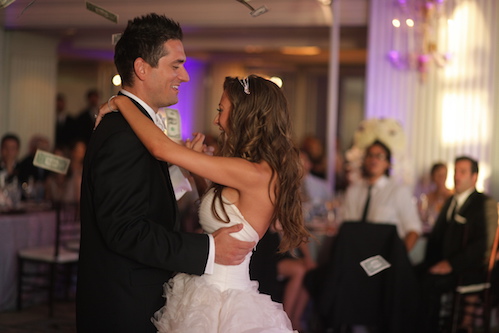Wedding Money Dance

Janna and Dimitri, Bella clients. Photo by Jim Kennedy.
The money dance is a wedding tradition found in a variety of cultures that is done during the wedding reception. During the wedding money dance, guests pay to briefly dance with the bride and groom. Depending on the culture, money may be attached to the bride and groom’s clothes or money may be thrown over the married couple. American brides from Louisiana, Oklahoma, Iowa, Texas, Ohio, and Wisconsin typically consider the money dance to be an important part of reception rituals. Generally, the money dance will take place toward the end of the formal festivities before most of the guest leaves. Other times, it is done as the last dance of the night. Sometimes guests are told that the money will be used for the married couples honeymoon or to set them up for a little extra cash in their new married life.
Wedding Money Dance
The custom is popularly believed to have originated in Poland in the early 1900s, but the money dance has been performed as a wedding ritual in a variety of cultures around the world ranging from Europe to South America to the United States. In Poland, the money dance takes place sometime after the first dance and is announced by the best man or the MC. Customarily, the best man begins dancing with the bride by pinning money onto her wedding gown or putting it into her designated money dance purse. In a more modern version of this Polish custom, the dance includes bridesmaids and other ladies who dance.
At Ukrainian weddings, the bride’s father typically begins the money dance by pinning money on the bride’s dress. The best man, the remaining groomsmen, and then the male guests follow him.
In the Yugoslavian wedding money dance, the male guests give the money to the best man for safe keeping instead of pinning the money on the bride.
In Hungarian and Portuguese weddings, the bride removes her shoes and puts them in the middle of the dance floor. Her shoes are then passed around the guests who each put money into her shoes as a contribution.
In Nigeria, the first dance and general opening of the dance floor invites guests to take turns approaching the bride and groom and “spray” them with small denominations of bills as they dance. Sometimes the mothers of the bride and groom are also included in the money dance. Often times the married couple will also be covered in leis and decorations made of money.
In the Filipino culture, the wedding money dance is very popular and is generally a boisterous peso-pinning game, which can last up to three hours in some small villages in the Philippines. A woven lei of money is usually placed around the couple’s neck and it’s also common for guests to place rolled-up bills or an envelope of cash into the brides mouth to symbolize good fortune.
In South America, the money dance is celebrated much in the same way it is done in the United States where guests pin money on the clothes of the bride and groom in exchange for a brief dance. This allows the bride and groom to spend a few dancing moments with each of their guests. In some parts of Mexico, the groomsmen ridicule the groom by dressing him up in an apron and veil and tossing him into the air after the money dance.
Even though the money dance is old tradition dating back to the early 1900s, it sometimes stirs up some debate around its etiquette soundness in the United States. The reason why the dollar dance is sometimes controversial is because in places where the dollar dance isn’t a standard custom, it can seem like a direct and public way of asking guests of a cash gift.
Wedding couples that would like to include the dollar dance in their wedding reception but are worried about how unknowing guests may receive the tradition sometime consider alternative options. One approach to the situation is to explain the meaning behind the dollar dance in a way that’s understandable to guests. The weddings’ MC or even a card on the reception tables could clear up any potential misunderstanding. An alternate to the money dance that some couples choose is to invite everyone to the dance floor and suggest they shower the bridge in groom with fake money, flower petals, or pieces of paper with well wishes.
In many cultures, the dollar dance is no reason for debate or question and is celebrated with encouragement. According to some wedding DJs, the dollar dance is done at about 50 percent of weddings in the US. Only the married couple-to-be can decide for themselves what will be the best choice for their wedding and whether the money dance tradition will be an appropriate choice for their day and their guests.
Article by Ziva

